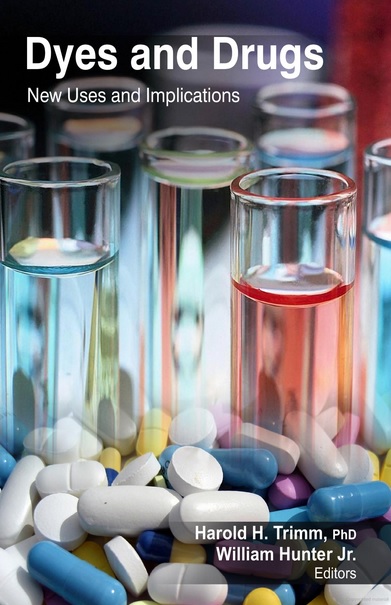By Harold H. Trimm, and William Hunter

Contents
1. Solvent Effect on the Spectral Properties of Neutral Red 11
Muhammad A. Rauf, Ahmed A. Soliman and Muhammad Khattab
2. The Degradation of Organic Dyes by Corona Discharge 23
S. C. Goheen, D. E. Durham, M. McCulloch and W. O. Heath
3. UV-Vis Spectrophotometrical and Analytical Methodology for 35
the Determination of Singlet Oxygen in New Antibacterials Drugs
Tamara Zoltan, Franklin Vargas and Carla Izzo
4. The Application of Resonance Light Scattering Technique for 50
the Determination of Tinidazole in Drugs
Xin Yu Jiang, Xiao Qing Chen, Zheng Dong and Ming Xu
5. Enhanced Trace-Fiber Color Discrimination by Electrospray 64
Ionization Mass Spectrometry: A Quantitative and Qualitative
Tool for the Analysis of Dyes Extracted from Sub-millimeter
Nylon Fibers
Albert A. Tuinman, Linda A. Lewis and Samuel A. Lewis, Sr.
6. The pKa Distribution of Drugs: Application to Drug Discovery 80
David T. Manallack
7. Determination of μmol-1 Level of Iron (III) in Natural Waters 103
and Total Iron in Drugs by Flow Injection Spectrophotometry
B. Sahasrabuddhey, S. Mishra, A. Jain and K. K. Verma
8. Design and Synthesis of a Noncentrosymmetric Dipyrromethene Dye 113
M. B. Meinhard, P. A. Cahill, T. C. Kowalczyk and K. D. Singer
9. The Function of TiO2 with Respect to Sensitizer Stability in 122
Nanocrystalline Dye Solar Cells
A. Barkschat, T. Moehl, B. Macht and H. Tributsch
10. Chromatographic and Spectral Analysis of Two Main Extractable 149
Compounds Present in Aqueous Extracts of Laminated Aluminum
Foil Used for Protecting LDPE-Filled Drug Vials
Samuel O. Akapo, Sajid Syed, Anicia Mamangun and Wayne Skinner
11. The Cold Contact Method as a Simple Drug Interaction Detection 162
System
Ilma Nugrahani, Sukmadjaja Asyarie, Sundani Nurono Soewandhi and
Slamet Ibrahim
12. NMR and Molecular Modelling Studies on the Interaction of 168
Fluconazole with β-Cyclodextrin
Santosh Kumar Upadhyay and Gyanendra Kumar
13. Spectrophotometric Determination of Etodolac in Pure Form 182
and Pharmaceutical Formulations
Ayman A. Gouda and Wafaa S. Hassan
14. Lead Optimization in Discovery Drug Metabolism and 196
Pharmacokinetics/Case Study: The Hepatitis C Virus (HCV)
Protease Inhibitor SCH 503034
K.-C. Cheng, Walter A. Korfmacher, Ronald E. White and
F. George Njoroge
15. Pressure-Tuning Raman Spectra of Diiodine Thioamide 210
Compounds: Models for Antithyroid Drug Activity
Ghada J. Corban, Constantinos Antoniadis, Sotiris K. Hadjikakou,
Nick Hadjiliadis, Jin-Fang Meng and Ian S. Butler
16. Uncertainty Analysis of Drug Concentration in Pharmaceutical 221
Mixtures
Michalakis Savva
17. Characterization of Thermally Stable Dye-Doped Polyimide 226
Based Electrooptic Materials
Michael B. Meinhardt, Paul A. Cahill, Carl H. Seager,
Allyson J. Beuhler and David A. Wargowski
18. Sol-Gel-Derived Silicafilms with Tailored Microstructures for 236
Applications Requiring Organic Dyes
Monica N. Logan, S. Prabakar and C. Jeffrey Brinker
19. Synthesis and Analysis of Nickel Dithiolene Dyes in a Nematic 246
Liquid Crystal Host
Irene Lippa
20. Synthesis of a Photoresponsive Polymer and Its Incorporation 259
into an Organic Superlattice
Alfred M. Morales, James R. McElhanon, Phillip J. Cole and
Chris J. Rondeau
21. An Efficient Drug Delivery Vehicle for Botulism Countermeasure 275
Peng Zhang, Radharaman Ray, Bal Ram Singh, Dan Li,
Michael Adler and Prabhati Ray
22. Estimation of Synthetic Accessibility Score of Drug-Like Molecules 291
Based on Molecular Complexity and Fragment Contributions
Peter Ertl and Ansgar Schuffenhauer
23. Rational Mutagenesis to Support Structure-Based Drug Design: 308
MAPKAP Kinase 2 as a Case Study
Maria A. Argiriadi, Silvino Sousa, David Banach, Douglas Marcotte,
Tao Xiang, Medha J. Tomlinson, Megan Demers, Christopher Harris,
Silvia Kwak, Jennifer Hardman, Margaret Pietras, Lisa Quinn,
Jennifer DiMauro, Baofu Ni, John Mankovich, David W. Borhani,
Robert V. Talanian and Ramkrishna Sadhukhan
24. Nanotechnology Approaches to Crossing the Blood-Brain Barrier 332
and Drug Delivery to the CNS
Gabriel A. Silva
Index 343
Introduction
The science of chemistry is so broad that it is normally broken into fields or branches of specialization. The manufacture of drugs and dyes is one of the most practical industrial applications of chemistry.
The development of dyes and medicines has always been connected. Scientists working to discover and synthesize both dyes and drugs developed the organic, synthetic chemistry that gave birth to the pharmaceutical industry at the end of the nineteenth century and the beginning of the twentieth. In fact, it was the accidental discovery of the first synthetic dye by Henry Perkin in England in 1856 that ushered in the age of synthetics. Perkin had been trying to synthesize the antimalarial drug quinine when he discovered a mauve dye later popularized by Queen Victoria. On the other side of this intimate connection between drugs and dyes, nineteenth-century chemists noticed the antibacterial properties some dyes exhibited in test tubes and then investigated their uses as therapeutic agents. Many proved to be quite useful. Paul Ehrlich, the German drug developer, systematically studied aniline dyes and modified them for use as drugs Research during the early years of dye synthesis produced compounds such as methylene blue and acriflavine, which were used as biological stains. The selectivity of such compounds for “non-economic” cells such as pathogenic bacteria or tumor cells gave rise both to the principle of selective toxicity and to the development of many modern drugs. The use of dyes in therapy is again gaining credence today, given the efficacy of light-activated drugs based on dye molecules against drug-resistant organisms such as MRSA. In addition, because of the ongoing prevalence of “superbugs”, older drugs developed from dye chromophores may again be of use in medical settings.
It is the intent of this collection to present the reader with a broad spectrum of articles in the particular area of drugs and dyes, thereby demonstrating key developments in this rapidly changing field.
